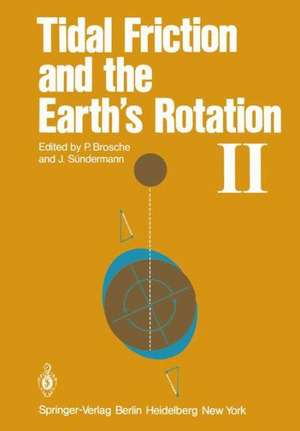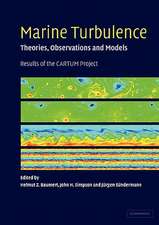Tidal Friction and the Earth’s Rotation II: Proceedings of a Workshop Held at the Centre for Interdisciplinary Research (ZiF) of the University of Bielefeld, September 28–October 3, 1981
Editat de P. Brosche, Jürgen Sündermannen Limba Engleză Paperback – 31 dec 1981
Preț: 646.43 lei
Preț vechi: 760.50 lei
-15% Nou
Puncte Express: 970
Preț estimativ în valută:
123.69€ • 129.49$ • 102.35£
123.69€ • 129.49$ • 102.35£
Carte tipărită la comandă
Livrare economică 07-21 aprilie
Preluare comenzi: 021 569.72.76
Specificații
ISBN-13: 9783540120117
ISBN-10: 3540120114
Pagini: 368
Ilustrații: XVI, 348 p. 30 illus.
Dimensiuni: 170 x 244 x 19 mm
Greutate: 0.59 kg
Ediția:Softcover reprint of the original 1st ed. 1982
Editura: Springer Berlin, Heidelberg
Colecția Springer
Locul publicării:Berlin, Heidelberg, Germany
ISBN-10: 3540120114
Pagini: 368
Ilustrații: XVI, 348 p. 30 illus.
Dimensiuni: 170 x 244 x 19 mm
Greutate: 0.59 kg
Ediția:Softcover reprint of the original 1st ed. 1982
Editura: Springer Berlin, Heidelberg
Colecția Springer
Locul publicării:Berlin, Heidelberg, Germany
Public țintă
ResearchDescriere
In the four years which elapsed between our first workshop on .Tidal Friction and the Earth's Rotation and the second, the proceedings of which are presented here, many of the disciplines involved made ad vances which we felt should be exchanged. We were encouraged by the good reception our first report met with. Of course, more insight often means more problems. Therefore, this volume contains new results and revisions of matters which previously appeared settled. We are certainly far from "final answers". For this reason, differing opinions on some issues are to be found in this book. Moreover, we have refrained from making mathematical symbols uniform to avoid the risk of errors and non-compatibility with the earlier work of an author. The two workshops have stimulated collaboration between participants working in various fields. The final versions of the contributions have already profited from these discussions. We are convinced that they will also influence further investigations. This advancement of our past and future aims is based on the very existence of the Centre for Interdisciplinary Studies and on the support we have received from its leading members. The authors have agreed to dedicate this book to Dr. H. Gerstenkorn, who died in 1981. He contributed fundamental ideas to the scientific fields treated in the meeting. P. Brosche Daun, September 1982 J. Slindermann Contents * Julius Robert Mayer's Ideas on a Theory of Tidal Friction H.P. Miinzenmayer ...•••.•••..••.•..•...••..•...•.•••.••••....•..
Cuprins
Julius Robert Mayer’s Ideas oil a Theory of Tidal Friction.- Tidal Friction Parameters from Satellite Observations.- 1. Introduction.- 2. Tidal Perturbations on Satellites Orbits.- 2.1 Solid Tide.- 2.2 Ocean Tide.- 3. Global Ocean Tide Models.- 4. Lunar Tidal Deceleration and Tidal Earth’ Q.- 5. Lunar Laser Ranging Results.- References.- On Some Topical Problems of the Dynamics of the Earth-Moon System.- 1. Introduction.- 2. The Earth-Moon Force Function.- 3. The Effect of R?c on the Earth’s Rotation Dynamics.- 4. Theoretical Non-Tidal Acceleration in the Moon’s Mean Motion on the Basis of Celestial Mechanics and the Non-Tidal Acceleration in the Earth’s Rotation.- 5. Other Phenomena.- 6. Conclusion.- References.- History of the Earth’s Rotation Since 700 B.C..- 1. Introduction.- 2. The Lunar Acceleration (n).- 3. Analyses of Telescopic Observations: 1620–1978.- 3.1 Decade Fluctuations: 1620–1860.- 3.2 Decade Fluctuations: 1861–1978.- 3.3 ?T Curve: 1620–1978.- 3.4 Changes in the Length of Day and Associated Torques.- 4. Medieval Fluctuations.- 4.1 Observations made by Clavius.- 4.2 Other Medieval Observations.- 4.3 ?T Variation in Medieval Times.- 5. Analysis of Ancient Observations.- 5.1 Discussion of Fotheringham’s Ancient Eclipse Data.- 5.2 Babylonian Lunar Eclipse Timings.- 5.3 Comparison with Ancient Observations of Large Solar Eclipses.- 6. Geophysical Implications.- References.- Deceleration of the Earth’s Rotation from Old Solar Observations.- 1. Introduction.- 1.1 ET and UT.- 1.2 Relation Between Time Scales.- 1.3 Longitude and Motion of the Sun.- 1.4 Length of the Tropical Year.- 2. Analysis of Solar Tables.- 2.1 Description of Tables.- 2.2 Longitude Comparison.- 3. The Length of the Year (Motion Comparison).- 3.1 Reduction of Equinox Observations.- 3.2 Hipparchus’ Equinox Observations.- 3.3 Arab Equinox Observations.- 3.4 Bernhard Walther’s Equinox Observations.- 3.5 Greenwich Equinox Observations.- 4. Conclusions.- References.- Long Time Integration of the Moon’s Orbit.- 1. Introduction.- 2. Physical Processes: A Qualitative Analysis.- 2.1 Forces.- 2.2 Equations of Evolution.- 2.3 Numerical Values.- 2.4 Precessional Equations.- 2.5 History of the Orbital Elements.- 4. Conclusion.- Appendix I. The Present Status of the Gravitational Secular Acceleration.- Appendix II. Precessional Equations.- References.- The Earth’s Non-Uniform Rotation.- 1. Introduction.- 2. Angular Momentum of the Atmosphere.- 3. The Decade Variations in the Length of the Day and Core-Mantle Coupling.- References.- The Rotation and the Magnetic Field of the Earth.- 1. Introduction.- 2. Weak or Strong Toroidal Fields?.- 3. Electromagnetic Core-Mantle Coupling.- References.- Gravitational Heating of Jovian Satellites by Tidal Friction.- References.- Balance Problems in Tidal Computations.- 1. Introduction.- 1.1 Observational Facts.- 1.2 Theoretical Approach.- 1.3 Motivation and Aims.- 2. Theoretical Considerations.- 2.1 General Physical and Celestial-Mechanical Remarks.- 2.1.1 On the Terminology of Balance Equations.- 2.1.2 Special Balance Equations.- 2.1.3 “Absolute” Balances of the Earth-Moon System.- 2.1.4 Interaction of the Subsystems.- 2.1.5 The Gerstenkorn Event.- 2.2 Oceanographical Remarks.- 2.2.1 The Consideration of Barotropic Tides and Its Implications.- 2.2.2 The Budget of Angular Momentum.- 2.2.3 The Budget of Kinetic Energy.- 2.2.4 The Budget of Potential Energy.- 3. Numerical Estimates.- 3.1 General Remarks.- 3.2 Angular Momenta with Respect to the Earth’s Rotation and Budget Quantities.- 3.2.1 Period Mean.- 3.2.2 The “Time-Resolved” Angular Momentum Budget.- 3.3 Mechanical Energies and Budget Quantities.- 3.3.1 Period Means.- 3.3.2 The “Time-Resolved” Kinetic Energy Budget.- 4. Conclusions.- A.1 General Physical and Celestial-Mechanical Considerations.- A.1.1 Balance Equations (General Form).- A.1.2 Special Balance Equations.- A.1.3 Conservation Relations in the “Absolute” System.- A.1.4 Interactions of the Subsystems and Simplifications.- A.1.5 Estimate for the Gerstenkorn Event.- A.2 Oceanic Considerations.- A.2.1 Derivation of the Model Equations.- A.2.2 The Balance Equation of Oceanic Angular Momentum.- A.2.3 The Balance Equation of the Oceanic Kinetic Energy.- A.2.4 On the Oceanic Potential Energies and Their Balances.- A.3 List of Symbols.- A.3.1 Normal Symbols and Some Dependent Quantities.- A.3.2 Mathematical Operators.- A.3.3 Subscripts.- A.3.4 Superscripts.- A.3.5 Transfers, Conversions and Storages.- References.- The Resonance Behavior of the World Ocean.- 1. Introduction.- 2. Tidal Resonance and Momentum Transfer.- 3. The Eigen Modes of the Present Ocean.- 4. Conclusions for the History of the Oceans.- References.- Tidal Friction for Times Around the Presence.- 1. Introduction.- 2. Extension of the Hydro dynamic-Numerical Model.- 3. Results.- 3.1 Tidal Elevations and Velocities.- 3.2 Movements of the Center of Mass.- 3.3 Balance of Energy.- 3.4 Balance of Angular Momentum and the Moon’s Torque on the Earth.- 4. Conclusions.- References.- Paleotides Before the Permian.- 1. Introduction.- 2. Method.- 2.1 Calculation of Tidal Torques.- 2.2 Calculation of Paleotides.- 3. Results.- 3.1 Silurian Paleotides.- 3.2 Ordovician Paleotides.- 3.3 Tidal Torques for Ancient Oceans.- 4. Discussion.- 5. Summary.- References.- On the Reduction in Tidal Dissipation Produced by Increases in the Earth’s Rotation Rate and Its Effect on the Long-Term History of the Moon’s Orbit.- 1. Introduction.- 2. The Ocean Model.- 3. The Astronomical Model.- 4. Results.- 5. Discussion.- References.- A Note on the Variability of Growth Increment Formation in the Shell of the Common Cockle Cerastoderma edule.- 1. Introduction.- 2. Different Types of Growth Patterns.- 3. Material and Method.- 4. Observations.- 5. Discussion.- References.- Paleogeography and Paleobathymetry: Quantitative Reconstructions of Ocean Basins.- 1. Introduction.- 2. Paleogeographic Reconstructions.- 2.1 Ocean Basins.- 2.2 Epicontinental Seas.- 3. Paleobathymetric Reconstructions.- 4. An Example: The Tertiary Atlantic Ocean.- References.- Mesozoic and Cenozoic Paleogeographic Maps.- 1. Introduction.- 2. Continental Fits.- 3. Paleomagnetic Orientations.- 4. Convergent Zones.- 5. Conclusions.- References.- Movements of the Continental Crust and Lithosphere-Aestenosphere Systems in Precambrian Times.- 1. Introduction.- 2. The Proterozoic Supercontinent.- 3. The Precambrian a.p.w. Path.- 3.1 2850–2200 m.y..- 3.2 2200–2000 m.y..- 3.3 2000–1750 m.y..- 3.4 1750–1520 m.y..- 3.5 1450–1125 m.y..- 3.6 Continental Breakup and Relative Movements at ca. 1100 m.y..- 3.7 1125–1000 m.y..- 3.8 1020–840 m.y..- 3.9 840–500 m.y..- 3.10 The Continental Breakup and Dispersal in Lower Cambrian Times.- 3.11 Summary of Continental Movements in Precambrian Times.- 4. Geophysical Implications of the Precambrian Palaeomagnetic Record.- 4.1 The a.p.w. Correlation Paradox and Limits to Change in the Earth’s Palaeoradius.- 4.2 The Axial Geocentric Dipole Assumption.- 4.3 The Intensity of the Precambrian Magnetic Field.- 4.4 The Polarity History of the Magnetic Field.- 5. Continental Concolidation and Lithosphere Development.- 5.1 The Evolution of Tectonic and Magmatic Environments.- 5.2 The Relationship to Lithosphere Development and Aesthenosphere Convection.- 6. Shelf Seas in Precambrian Times.- 6.1 Deduction from the Geological Record.- 6.2 Implications to Tidal Friction.- References.- Chemical and Isotopic Evidence for the Early History of the Earth-Moon System.- 1. Introduction.- 1.1 Primordial Abundances of Chemical Elements.- 1.2 Chemistry of Meteorites.- 1.3 Fractionation of Chemical Elements with Respect to Their Volatility.- 2. Basalts from Four Planets.- 3. Correlated Elements.- 4. Chemistry and Formation of Earth and Moon.- 4.1 Chemistry of the Earth.- 4.2 Accretion Sequence of the Earth and the Other Inner Planets.- 4.3 Chemistry of the Moon.- 4.4 Mn, Cr and V in the Earth’s Mantle and the Moon.- 5. Origin of the Moon.- References.- Concluding Remarks.













